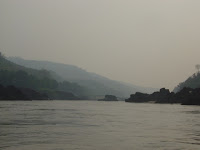









I am back with some more up-dates. As a matter of fact, I will have to divide the last couple of days into different posts.
Welcome to Laos and to the Mekong river! Called the 'mother of all Waters' in Laos, the Mekong River, at 4800 kilometres, is the longest river in South East Asia (the 4th longest in Asia), and the 10th longest in the world. The Mekong has its origin in the Tibetan Plateau and passes through China, Myanmar, Thailand, Laos and Cambodia before finally emptying into the South China Seas in the Mekong Delta area of Vietnam. The Mekong annually carries around 475'000 million cubic metres of water in the sea and in Laos. The current is very strong and unpreditable with whirlpools and basalt rock formations, making it difficult to bridge. There are only two bridges on the Mekong river, both being in Laos, one at the Friendship Bridge linking Vietiane with Nong Khai and the other in Pakse. The river has been worshipped for thousands of years and is still the artery of life in Laos: a trading route, a source of food and water, and a social centre for the settlements along it's route. Over 70% of the protein in their diets is from Mekong river fish and in the try season with low water level the silt deposits are used to grow peanuts and rice. The scenery is just amazing!
Welcome to Laos and to the Mekong river! Called the 'mother of all Waters' in Laos, the Mekong River, at 4800 kilometres, is the longest river in South East Asia (the 4th longest in Asia), and the 10th longest in the world. The Mekong has its origin in the Tibetan Plateau and passes through China, Myanmar, Thailand, Laos and Cambodia before finally emptying into the South China Seas in the Mekong Delta area of Vietnam. The Mekong annually carries around 475'000 million cubic metres of water in the sea and in Laos. The current is very strong and unpreditable with whirlpools and basalt rock formations, making it difficult to bridge. There are only two bridges on the Mekong river, both being in Laos, one at the Friendship Bridge linking Vietiane with Nong Khai and the other in Pakse. The river has been worshipped for thousands of years and is still the artery of life in Laos: a trading route, a source of food and water, and a social centre for the settlements along it's route. Over 70% of the protein in their diets is from Mekong river fish and in the try season with low water level the silt deposits are used to grow peanuts and rice. The scenery is just amazing!

No comments:
Post a Comment